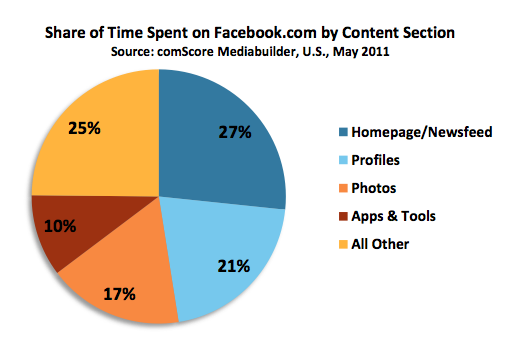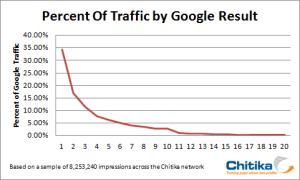
Nick Bilton of The New York Times recently noted that, at some point following the implementation of Facebook’s “Sponsored Posts” feature, his non-sponsored posts started receiving far less exposure than before:
Early last year, soon after Facebook instituted a feature that let people subscribe to others’ feeds without being friends, I quickly amassed a healthy “subscriber” list of about 25,000 people…
Since then, my subscribers have grown to number 400,000. Yet now, when I share my column, something different happens. Guess how many people like and reshare the links I post?
If your answer was over two digits, you’re wrong.
From the four columns I shared in January, I have averaged 30 likes and two shares a post. Some attract as few as 11 likes. Photo interaction has plummeted, too. A year ago, pictures would receive thousands of likes each; now, they average 100. I checked the feeds of other tech bloggers, including MG Siegler of TechCrunch and reporters from The New York Times, and the same drop has occurred.
What changed? I recently tried a little experiment. I paid Facebook $7 to promote my column to my friends using the company’s sponsored advertising tool.
To my surprise, I saw a 1,000 percent increase in the interaction on a link I posted, which had 130 likes and 30 reshares in just a few hours. It seems as if Facebook is not only promoting my links on news feeds when I pay for them, but also possibly suppressing the ones I do not pay for.
Following this article, Reuters’ Anthony De Rosa spoke to a Facebook rep and then posted a short list of three misconceptions that he implied Bilton — and/or others like him — had disseminated. Among them:
Misconception #1: Sponsored/Promoted Content is replacing organic content on Facebook I spoke to Vadim Lavrusik, Facebook’s journalism program manager. Here’s what he told me:
“One important thing to understand is that when someone promotes a post in feed and pays to promote it, the stuff that’s getting distribution organically still gets distribution, it doesn’t get replaced from feed. It may get a lower placement, but it doesn’t get replaced. And the placement of the sponsored post or promoted post is also based on the quality of that post (so promoted content still has a quality algorithm attached to it.) If the promoted post isn’t that good, it gets lower placement, but it will get more distribution either way because it’s being paid for, but it’s still takes quality into account.
The claim that I’ve seen explains it as if these paid posts replace organic posts, which isn’t the case. The News Feed algorithm is separate from the advertising algorithm in that we don’t replace the most engaging posts in News Feed with sponsored ones.”
This seems like a distinction without a difference. One can hardly blame Lavrusik for trying to disguise his employer’s tactics with this line of defense, but it’s not very convincing.
Why not? Well, first of all, he states that “when someone promotes a post in feed and pays to promote it, the stuff that’s getting distribution organically still gets distribution, it doesn’t get replaced from feed. It may get a lower placement, but it doesn’t get replaced.” But for all intents and purposes, being bumped to a lower placement is the exact same thing as getting replaced. Lavrusik knows this, of course, but it’s not in his — or Facebook’s — interest to acknowledge it.

Facebook’s News Feed is infinite: when you scroll down, it loads more posts. In other words, there’s no real estate scarcity going on here. As long as you keep scrolling, Facebook will keep loading. But much like Google’s search rankings, everyone knows that it’s generally the first listings that get by far the most attention. For example, this study demonstrates that just under 95% of all Google clicks come from the first page of search results. All subsequent results pages combined represent barely over 5% of click-throughs.
I’d venture a guess that the Facebook News Feed has a similar-looking curve. Of course, its average time-on-site is going to be a lot higher than Google’s, but the same laws apply — the farther down the page something is, the less likely it is that a user will see it. Sponsored Posts, by definition, push non-sponsored posts farther down the page. Ergo, they are less likely to be seen. So even if it’s technically true, when Lavrusik says a non-sponsored post “doesn’t get replaced,” he’s not saying anything meaningful at all.
My second disagreement with De Rosa on this point has to do with his conclusion:
There’s a few things that make Nick an edge case, someone who uses and experiences Facebook slightly differently than the broader membership. He was one of the privileged few who were “recommended” members to follow, which allowed him to gain a lot of followers early on. Most members have to scratch and claw to get noticed, a recommended user list gives you an opportunity to catapult your following in a less organic fashion. Just like on Twitter, it creates an inauthentic illusion of “influence,” and as much as I loathe that word and the next one I am going to use, “engagement,” the quality of that “engagement” goes down as your artificial following grows.
I also noticed that Nick tends to post a lot of links, instead of photo posts, which tend to get a lot more “likes” “shares” and comments. If they’re not getting that kind of (ugh) “engagement,” then they’re in turn showing up lower organically in your follower’s newsfeed. This is a feature, not a bug.
But as Bilton himself mentioned:
From the four columns I shared in January, I have averaged 30 likes and two shares a post. Some attract as few as 11 likes. Photo interaction has plummeted, too. A year ago, pictures would receive thousands of likes each; now, they average 100. I checked the feeds of other tech bloggers, including MG Siegler of TechCrunch and reporters from The New York Times, and the same drop has occurred.
In other words, Bilton is not comparing apples and oranges. He’s comparing similar posts from before and after Facebook’s methodology change. So De Rosa’s comment on the fact that user engagement differs by the type of content doesn’t apply here.
Anecdotally, I’m a fairly standard Facebook user: I have around 700 friends and I don’t believe I have any subscribers. (To be honest, I can’t remember whether I ever set up my profile to allow it.) And I’ve noticed very similar patterns to Bilton’s regarding engagement on my own posts. I can’t speak for Nick Bilton, but I’m quite sure I’m not an edge case.
Just to be clear, there’s nothing wrong with Facebook’s strategy here. Especially now that it’s public, its responsibility is to make money for its shareholders, and the implementation of Sponsored Posts makes a lot of sense on certain levels. Vadim Lavrusik’s defense is similarly understandable: he works for Facebook, so his slick reasoning is to be expected. But that doesn’t mean any of us should be remotely convinced by it.


















 I just conducted a quick spot check, and was horrified to learn that — in the entire history of this blog — I have devoted only
I just conducted a quick spot check, and was horrified to learn that — in the entire history of this blog — I have devoted only  at the appearance of “AOL” in the vaunted crossword puzzle over the years:
at the appearance of “AOL” in the vaunted crossword puzzle over the years: